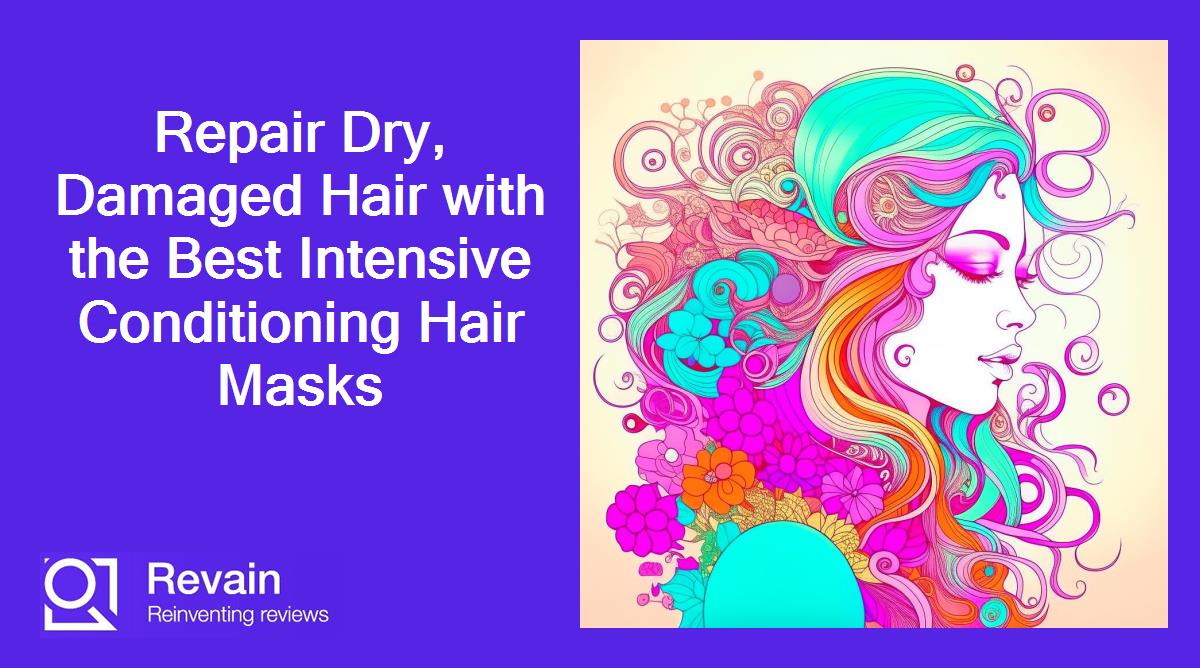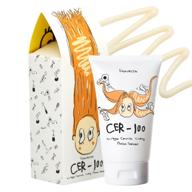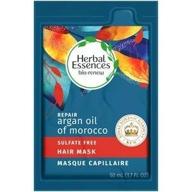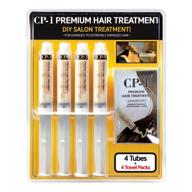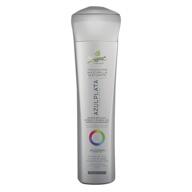Similar products
The Trouble With Dry, Damaged Hair And How Masks Can Help
Dry, damaged hair is a common struggle for many people. Exposure to harsh weather, over-washing, chemical treatments, and heat styling can all take a toll on your hair's health and cause it to become brittle, frizzy, and unmanageable. This kind of long-term damage can be difficult to undo, but using restorative hair masks is one of the most effective ways to get your locks back into shape.
Top products in 💆♂️ Hair Masks
Common Causes of Dry, Damaged Hair
- Frequent heat styling with hot tools like blowdryers, curling irons, and straighteners
- Over-washing and using harsh shampoos that strip natural oils
- Chemical services like perms, relaxers, or dyeing
- Not properly conditioning after washing
- Environmental factors like sun, wind, salt water, or chlorine damage
All of these factors can damage the hair cuticle, remove moisture, and cause the shafts to become weak and prone to breakage over time. This leads to obvious symptoms like frizz, tangling, split ends, and overall dull or dry looking hair.
How Hair Masks Help Repair Damage
Hair masks are intensive conditioning treatments that help restore moisture, strength, and shine to damaged locks. Here's how they help:
- Contain rich oils, butters, ceramides that nourish hair
- Deeply hydrate and smooth down the hair cuticle
- Strengthen hair shaft from inside out to prevent breakage
- Protect against environmental stressors like sun or pollution
- Boost shine and silkiness for healthier look and feel
When used consistently 1-2 times per week, high quality hair masks can make a big difference in the overall condition of damaged hair. Certain ingredients like shea butter, argan oil, and keratin can target specific issues like dryness or frizz as well.
Another interesting products
Tips for Using Hair Masks Effectively
To get the most out of your chosen hair mask, follow these tips for applying and using them:
- Start with clean, damp hair - masks work best on freshly washed hair
- Evenly distribute a generous amount from roots to ends
- Cover hair with a shower cap if possible to retain heat and allow deeper penetration
- Leave on for 5-15 minutes or more for intensive conditioning
- Rinse out thoroughly with cool water
- Use once or twice a week for best results
Target the masks to the most damaged sections of hair for an added boost. Over time, you should notice a real improvement in texture, frizz, softness, and manageability.
Don't give up if damaged hair doesn't improve overnight. Consistency is key when repairing long term issues like dryness or breakage. But used properly, hair masks can be a real game-changer and help restore your locks to their healthiest, shiniest state.
Masks For Different Hair Types: Solutions For Each Struggle
Not all hair is created equal. Different hair types have their own unique challenges and concerns. The key to choosing the right hair mask is finding one tailored to the needs of your hair type.
Hair Mask Solutions for Dry Hair
Dry, brittle hair lacks moisture and oils. This leads to frizz, tangling, and breakage. Intense hydration is key:
- Look for masks with oils like argan, coconut, or avocado
- Sheal butter, macadamia oil, and honey also nourish dry hair
- Glycerin, panthenol, and hyaluronic acid attract moisture
- Avoid proteins that can be overly drying
- Deep condition 1-2 times per week to hydrate parched strands
An example is SheaMoisture's Hydrate & Repair Protein Power Treatment. It contains moisturizing ingredients like shea butter, honey, sea kelp, and argan oil to replenish hydration in dry, damaged hair.
Hair Mask Solutions for Oily Hair
Oily hair tends to look greasy and limp. The roots get oily faster. These hair types need lightweight moisture:
- Look for oil-free or mattifying masks
- Clay, apple cider vinegar, and lemon help absorb excess oils
- Grapeseed, jojoba, and tea tree oils add shine without grease
- Use sparingly to avoid weighing hair down
- Focus on ends which need hydration but avoid roots
An example is L'Oreal Paris' Pure Clay Mask. It contains kaolin clay and apple cider vinegar to soak up dirt and oil without stripping hair. The yucca extract also adds a healthy shine.
Hair Mask Solutions for Curly Hair
Curly hair needs extra moisture and frizz reduction. These are ideal ingredients:
- Look for creamy, thick masks to weigh curls down
- Oils like olive, avocado, and coconut hydrate without grease
- Shea butter, aloe vera, and panthenol provide curl definition
- Avoid sulfates and silicones that dry out curls
- Scrunch and rake masks through coils and ringlets
An example is Not Your Mother's Curl Talk Masque which has coconut oil, aloe vera, and shea butter to deeply nourish unruly, frizzy curls.
Hair Mask Solutions for Color Treated Hair
Chemically treated hair needs bonding and protection. Look for these ingredients:
- Keratin, collagen, and oils reinforce damaged strands
- UV filters shield against fading from sun exposure
- Rice water, oat protein, and ceramides strengthen and smooth
- Opt for color-safe, sulfate-free formulas
- Evenly coat each strand to prevent uneven fading
An example is Redken's Color Extend Magnetics Mask which has amino acids and cranberry oil to nourish color treated hair and enhance shine.
No matter your hair type, reading reviews and doing a patch test before using a new mask can help avoid disasters. With some trial and error, you can find the perfect mask to target your specific hair challenges.
DIY Hair Masks: Natural Ingredients To Mix Up At Home
Making your own custom hair masks at home is a great way to treat your hair to some TLC. With the right combination of natural ingredients, it’s easy to whip up hydrating, strengthening, and nourishing masks targeted to your hair’s needs.
Base Ingredients
Good bases for hair masks provide moisture, slip, and emulsify the other ingredients. Great options are:
- Avocado
- Banana
- Coconut milk
- Plain Greek yogurt
- Mayonnaise
- Honey
- Olive oil
- Eggs
Hydrating Ingredients
If your hair is dry or damaged, add in hydrators like:
- Aloe vera gel
- Coconut oil
- Glycerin
- Jojoba oil
- Cocoa butter
- Shea butter
Strengthening Ingredients
Looking to strengthen your strands? Try mixing in:
- Honey
- Coconut or olive oil
- Eggs
- Greek yogurt
- Rice water
- Avocado
Soothing Ingredients
If your scalp is dry or irritated, soothing ingredients like these can help:
- Aloe vera
- Coconut milk
- Honey
- Mint leaves
- Green tea
- Chamomile tea bags
Making Your Mask
When making DIY hair masks, it's best to:
- Use approximately 2 tablespoons of oils and butters per 1/4 cup of cream base
- Add liquids like aloe slowly to get right consistency
- Mix ingredients in a blender or food processor until smooth.
- Store in an airtight container and refrigerate leftovers
- Perform a patch test on your arm before applying mixes
Play around with ingredient combos and write down any effective recipes you come up with. Making your own hair masks can be a fun and affordable way to give your hair some extra TLC with natural ingredients.
How To Use Hair Masks: Tips For Applying And Rinsing Out
Using a hair mask is an easy way to give your locks some extra nourishing and hydration. But how you apply and rinse out a hair mask can make all the difference in how effectively it treats your hair. Follow these tips to get the most out of your hair masking routine.
Prep Your Hair
Always start with freshly cleaned hair - masks work best on hair that has been shampooed and conditioned. Avoid using other styling products before applying a mask.
Towel dry hair after washing so it remains damp but not sopping wet before mask application. Damp hair allows better absorption of the mask's nutrients.
Use a wide-tooth comb or brush to detangle hair beforehand to allow the mask to evenly coat strands.
Application Tips
- Scoop out a generous amount of mask, approximately the size of a lemon.
- Rub hands together to evenly distribute product and warm it up before applying.
- Start at roots and thoroughly work through to ends, ensuring full coverage.
- Add extra product to any extremely damaged portions.
- If hair is thick or long, section hair to better target each area.
- Use a comb or brush to evenly distribute mask from scalp to ends.
Processing Time
Most masks need 10-15 minutes processing time. For a deeper treatment:
- Cover hair with a shower cap to retain heat and allow better penetration.
- Wrap head in a warm towel for added heat.
- Keep mask on for up to 30 minutes or overnight for intensive conditioning.
Rinsing Out Mask
Rinse hair mask out thoroughly with lukewarm water. Avoid hot water, which could undo the mask's nourishing effects.
Focus the water flow directly on your scalp and roots area first where product buildup tends to gather.
Gently glide fingers through hair from roots to ends to help remove all traces of mask.
Avoid rubbing or tangling hair, which can cause damage to the cuticle.
For extra softness, finish with a cool water rinse, which helps seal in moisture.
Repeat the cleansing and conditioning process if hair still feels coated after rinsing.
Use hair masks once or twice per week for optimal nourishment without weighing hair down.
The Best Hair Masks To Repair Summer Sun Damage
Too much time in the sun without protection can take a real toll on your hair's health. The sun's UV rays cause damage like dryness, frizz, faded color, and more brittle strands. Fortunately, using the right hair mask can help undo some of that summer sun damage.
What Sun Damage Does To Hair
Here are some of the common effects prolonged sun exposure has on hair:
- Dryness from the drying effects of the sun
- Faded color from UV rays stripping color pigments
- Brittleness from degradation of the hair proteins
- Frizz due to damage to the outer cuticle layer
- Overall dullness and lack of shine
Key Ingredients To Target Sun Damage
Look for hair masks that contain ingredients like:
- Oils: Coconut, argan, avocado to nourish dry strands
- Butters: Shea and cocoa butter to smooth and hydrate
- Keratin: Helps strengthen and repair internal damage
- Silicones: Seal the cuticle to boost shine
- UV Filters: Help protect against further sun damage
Top Masks To Repair Summer Damage
Here are some top-rated hair masks to recover from sun exposure:
Verb Hydrating Mask
- Contains moringa seed oil to nourish and smooth
- Shea butter and glycerin boost moisture
- Helps hair look visibly healthier after one use
- Light tropical scent
Briogeo Don't Despair, Repair!
- Rosehip, coconut, and argan oils deeply condition
- Keratin and B-vitamins strengthen strands
- Works well to restore very dry, damaged hair
- Cruelty-free and made with natural ingredients
Moroccanoil Intense Hydrating Mask
- Argan oil, fatty acids, and antioxidants nourish hair
- Helps control frizz and flyaways
- Instantly leaves hair looking shinier
- Has a signature Moroccanoil scent
Shea Moisture Manuka Honey & Mafura Oil
- Certified organic and fair trade ingredients
- Intensely hydrates dry, brittle hair
- Australian baobab oil boosts shine
- Affordable compared to other options
Using an intensive conditioning hair mask weekly can help damaged hair regain its healthy appearance. Just be sure to always protect hair from UV rays to prevent repeat damage going forward.
Common Mistakes When Using Hair Masks And How To Avoid Them
It’s easy to get excited about using a hair mask and all the nourishing benefits it can provide. But there are some common mistakes people make that prevent you from getting the most out of hair masks. Avoid these issues to make hair treatments more effective.
Applying Masks to Dirty Hair
Don't skip the shampoo! Hair masks work best on clean hair. Any dirt, oil, or product buildup will create a barrier that prevents masks from properly penetrating the hair shaft.
Always shampoo and condition hair before applying any hair mask. This allows the mask to absorb better.
Using Too Much Product
It may be tempting to overdo it with a thick layer of mask, but too much can actually weigh hair down and lead to a greasy look. All you need is:
- About a lemon-sized amount for shoulder length hair
- Up to a golf ball amount for long or thick hair
Focus on distributing the mask evenly from roots to ends rather than piling on extra globs.
Failing to Cover All Sections
When applying a hair mask, it's important to fully coat every section of your hair, not just the lengths and ends. This ensures all areas get conditioned.
Section out hair and use clips if needed to fully saturate every strand from root to tip.
Not Leaving on Long Enough
Masks need adequate time to penetrate the hair shaft. Leaving on for just 1-2 minutes isn't enough. Optimal processing time is:
- 15-20 minutes for regular use
- 30-45 minutes for deeper conditioning
- Up to overnight for an intensive treatment
Cover with a shower cap or wrap hair in a warm towel to help the mask efficiently treat hair.
Insufficient Rinsing
You want to thoroughly rinse out all traces of hair mask so hair doesn't feel heavy or greasy. Make sure to:
- Rinse with lukewarm water, not hot
- Rinse for at least 2-3 minutes
- Comb through hair under running water to remove residue
- Do a final cold water rinse to seal cuticles
Repeat cleaning process if needed to eliminate mask remnants after rinsing.
Using Too Frequently
It's possible to overdo it with hair masks. Stick to:
- 1-2 times per week for normal hair
- Every other day for damaged or very dry hair
Too much can lead to product buildup and greasy, limp strands.
Following proper application and usage tips will help you avoid common pitfalls when using reparative hair masks.
Hair Mask Solutions For Dry And Damaged Hair
Dry and damaged hair can be a frustrating problem to deal with, but there are many hair mask solutions available to help. Here are some options:
Hair Masks for Dry and Damaged Hair Available in the Market:
- K18 Leave-In Repair Hair Mask Treatment to Repair Dry or Damaged Hair - 4 Minutes to Reverse Hair Damage from Bleach, Color, Chemical Services and Heat.
- Eva NYC Therapy Session Hair Mask, Deep Conditioning Hair Mask for Dry Damaged Hair, Moisturizing Hair Treatment with Argan Oil & Plant Protein, 16.9 fl Oz.
- Olaplex No. 8 Bond Intense Moisture Mask.
- Moroccanoil Intense Hydrating Hair Mask.
- Briogeo Don't Despair Repair Hair Mask, Deep Conditioner for Dry Damaged or Color Treated Hair, Treatment for Repair, 8 oz.
- CRISTALBOX Keratin Hair Mask,Deep Repair Damage Hair Root, 250ml Hair Mask for Dry Damaged Hair,Hair Treatment Mask Keratin Hair & Scalp Treatment,Natural Deep Conditioner Hydrating Hair Masque.
- Pantene Hair Mask, Miracle Rescue Deep Conditioning Treatment, Hydrate Dry Hair, Pack of 2, 8 Oz Each.
DIY Hair Masks for Dry and Damaged Hair:
- Egg, honey, and olive oil with other hydrating ingredients make a good budget-friendly mask for dry hair.
- Aloe vera can be used as a hair mask to add moisture to dry hair.
- A deep conditioning mask is one of the best methods to rejuvenate your dry hair.
- Coconut oil, milk and honey, banana and olive oil, avocado and olive oil, and egg are some of the ingredients that can be used to make DIY hair masks for dry hair.
- Hair masks can be customized to meet specific hair concerns, depending on hair type.
Tips for Choosing the Right Hair Mask for Dry and Damaged Hair:
- Look for hair masks specifically designed to enrich hair with moisture and hydration.
- Choose a formula that’s especially thick and nourishing if your hair is on the curly or coarse side.
- Look for ingredients like plant-based butters and oils such as shea butter and coconut, olive, and castor oils.
- Ensure you use a gentle shampoo and conditioner. Harsh products can do more harm than good to your hair and scalp.
How Often Should I Use A Hair Mask For Dry And Damaged Hair?
The frequency of using a hair mask for dry and damaged hair depends on the hair type and the condition of the hair. Here are some general guidelines:
- Dry Hair: 2 to 3 Times Per Week - If you have dry hair, you can use a hair mask multiple times per week to provide your hair with the necessary moisture and nourishment. Look for a mask with intense hydration that will seal in moisture and give your dry hair new life.
- Damaged Hair: 2 to 3 Times Per Week - For damaged hair, using a moisturizing mask a few times a week can help restore it. Hair masks are just the thing to help you restore damaged hair.
- Fine or Oily Hair: Once a Week (Or Every Other Week) - If you already have plenty of natural oils permeating your scalp or your strands are fine and feathery, keep hair mask usage to about once a week, or even less. This schedule will help you avoid weighing down your hair with too much moisture-rich hydration or throwing off the balance of your natural oils by adding unnecessary moisture.
- Thick Hair: Up to 3 Times Per Week - Unlike other hair types, there's little danger of overloading thick hair with excess moisture, so you can apply a hydrating mask up to three times a week.
- Thin Hair: Once a Week to Every Other Week - Thin hair is the hair type most likely to get overloaded by hydrating hair masks, so apply hair masks once a week to every other week.
- Long Hair: Apply a hair mask once a week to avoid overloading your fragile strands.
- Afro Hair: One to two times a week is an ideal frequency for afro hair. Regular application of a hair mask will help to protect, grow and strengthen strands to avoid breakages and maintain a soft and shiny condition to hair.
It's important to note that these are general guidelines, and you should adjust the frequency of using a hair mask based on your hair type and the condition of your hair.
What Are Some Signs That My Hair Needs A Hair Mask?
There are several signs that your hair needs a hair mask. Here are some of them:
- Brittle hair and split ends: If your hair is breaking easily and has split ends, it's a sign that it needs a hair mask to help repair and strengthen it.
- Dull-looking hair: If your hair looks lifeless and lacks shine, it may be a sign that it needs a hair mask to restore its vibrancy.
- Itchy scalp: If you have an itchy scalp, it may be a sign that your hair is dry and needs a hair mask to add moisture.
- Frizzy hair: If your hair is frizzy and unmanageable, it may be a sign that it needs a hair mask to tame it and add moisture.
- Rough hair: If your hair feels rough to the touch, it may be a sign that it needs a hair mask to add moisture and smooth it out.
- Color-treated hair: If you color your hair regularly, it may be a sign that it needs a hair mask to keep it soft, healthy, and full of shine.
- Post-haircut: After a haircut, your hair may feel smoother and softer, but a hair mask can provide extra nourishment and hydration.
It's important to note that these are general signs, and you should adjust the frequency of using a hair mask based on your hair type and the condition of your hair.






